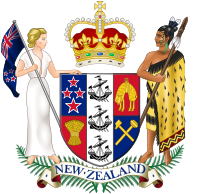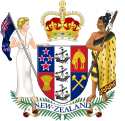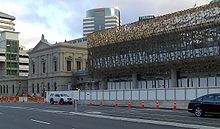- Supreme Court of New Zealand
-
Supreme Court of New Zealand
Kōti Matua o Aotearoa
Established 1 January 2004 Jurisdiction New Zealand Location 85 Lambton Quay, Wellington Composition method Appointed by by the Governor-General on behalf of Queen Elizabeth II on the advice of the Prime Minister (Chief Justice) and Attorney-General (Justices) Authorized by Supreme Court Act 2003 Judge term length Life tenure (Constitution Act 1986, s 23) Number of positions 6 Website courtsofnz.govt.nz Chief Justice Currently Rt Hon. Dame Sian Elias, GNZM PC QC Since 1 January 2004 New Zealand 
This article is part of the series:
Politics and government of
New ZealandConstitution General
The Supreme Court of New Zealand (in Māori: Te Kōti Matua o Aotearoa) is the highest court and the court of last resort in New Zealand, having formally come into existence on 1 January 2004. The court sat for the first time on 1 July 2004. It replaced the right of appeal to the Judicial Committee of the Privy Council, based in London. It was created with the passing of the Supreme Court Act 2003, on 15 October 2003. At the time, the creation of the Supreme Court and the abolition of appeals to the Privy Council were controversial constitutional changes in New Zealand.
It should not be confused with New Zealand's "old" Supreme Court, which was a superior court that was established in 1841 and continued in 1980 as the High Court of New Zealand. The name was changed in anticipation of the eventual creation of a final court of appeal for New Zealand that would be called the "Supreme Court".
Contents
Composition
The inaugural bench (with the exception of the Chief Justice, who had automatic appointment) were the most senior judges of the New Zealand Court of Appeal at the time. Their appointment to the new Court was said to have been based on seniority and merit. The maximum bench under statute is six judges.[1]
Several acting Judges have also been appointed to sit whenever a permanent judge was unable to do so due to illness or a conflict of interest. These judges were appointed from the retired judges of the Court of Appeal and including Justices Sir John Henry, Sir Ted Thomas, former President of the Court of Appeal Sir Ivor Richardson and former Chief Justice Sir Thomas Eichelbaum. Acting judges only sit on substantive appeals, and not applications for leave, due to the requirement for appeals to be heard en banc by five judges.
On 4 May 2005, Attorney General Michael Cullen announced the appointment of Justice Sir John McGrath of the Court of Appeal to the Supreme Court bench as its sixth permanent judge. On 21 February 2006, the Honourable Sir Noel Anderson (at the time President of the Court of Appeal) was appointed to the Supreme Court. Thus the promotion of the most senior Court of Appeal member has continued. This practice was broken with the appointment of Justice Bill Wilson in December 2007 after having served less than a year as a judge of the Court of Appeal.
Background
While the suggestion of ending appeals to the Privy Council had been around since the Statute of Westminster Adoption Act 1947,[2] proposals to end appeals to the Privy Council began in the late 1970s, when a Royal Commission on the judiciary canvassed arguments for replacing the Privy Council.[3] In the early 1980s, Minister of Justice Jim McLay suggested their abolition.[4] Proposals for an indigenous final appellate court can be traced back to 1985. In 1996, Paul East, Attorney-General of the Bolger government, proposed to end the status of the Privy Council as the country's highest court of appeal. The proposal got as far as a Bill being introduced into Parliament. However, this Bill met with little support from within the National Party, and the Bill was not carried over by the next Parliament following the 1996 general election.[4]
The policy was resurrected in 1999 by the Fifth Labour Government of 1999 – 2008. A discussion paper, Reshaping New Zealand's Appeal Structure attracted 70 submissions.[3] A year later a Ministerial Action Group was formed to assist Ministers in designing the purpose, structure and make-up of a final court of appeal. The Group's report, Replacing the Privy Council: A New Supreme Court was published in April 2002,[5] before the general election a few months later.[3] Upon the re-election at the New Zealand general election, 2002, as part of the Labour Party's election manifesto, the Attorney-General, Labour's Margaret Wilson, introduced the Supreme Court Bill to create the Supreme Court and abolish appeals to the Privy Council on 9 December 2002.[3] The Monarchist League of New Zealand began a campaign against the abolition of appeals, stating "Most lawyers are opposed to the abolition of appeals to the Privy Council, and doubtless will continue to do so until a more satisfactory justification is given for the abandonment of a tribunal which costs the New Zealand taxpayer nothing, and which gives us access to some of the finest legal minds in the common law world. Many Maori also see this proposal as a retrograde step, both by removing an impartial tribunal to which they have hitherto been able to appeal, and by cutting another link with the Crown."[6] Margaret Wilson argued in favour of the Bill, stating "When reviewing the legal needs of the community appeals to the Privy Council seemed increasingly anomalous. It was anomalous because of the narrow range of cases that actually were appealed to the Privy Council. The Privy Council itself recognised that some cases it considered were better settled by a New Zealand court and referred back for decision. Its precedent value was therefore quite limited. Few cases got to the Privy Council because of the costs involved, and because in some areas, such as employment and environment law, the statutes barred such appeals."[7]
Select Committee
At select committee, the Bill attracted numerous submissions for and against creating the Supreme Court. Notable supporters of the Supreme Court were former Privy Councillor Baron Cooke of Thorndon and former Prime Minister Sir Geoffrey Palmer, while most senior lawyers were opposed to the change.[3] The Monarchist League complained the majority of members of the select committee were motivated by a "republican agenda".[8]
Third reading
The Supreme Court Act 2003 passed its third reading by a relatively small margin – the governing Labour and Progressive parties, supported by the Greens, voted in favour, while the National, New Zealand First, ACT New Zealand, and United Future parties voted against. It received Royal Assent on 17 October 2003, with commencement on 1 January 2004.
In 2008, National leader John Key (now Prime Minister) ruled out any abolition of the Supreme Court and return to the Privy Council.[9]
Referendum petition
After the Opposition parties unsuccessfully called for a national referendum on the matter, Auckland lawyer Dennis J Gates launched a petition for a non-binding citizens initiated referendum on 3 April 2003, asking the question "Should all rights of appeal to the Privy Council be abolished?".[10] The petition failed to gain the 310,000 signatures of registered electors needed and lapsed on 2 July 2004.
Appointments
One issue that was particularly contentious as the Bill was being debated in Parliament was the appointment of judges to the Court, with opposition parties claiming that the Attorney-General would make partisan choices.[7] These concerns were because the entire bench was to be appointed simultaneously, and no clear statement had been made about how they would be selected. However, the level of concern was considerably lessened when Wilson announced that the appointments would be based on merit and seniority. Appointments to the Court were expected and unsurprising. The most senior Justices on the Court of Appeal were appointed to the new Court.
Cases
One of the grounds advanced for the creation of the Court was that it would allow more people to have access to the country's highest appellate court. From 1851 until 2002, the Privy Council made 268 decisions relating to New Zealand. In the ten years from 1992–2002, only 21 decisions had been allowed with respect to New Zealand.[5] The Supreme Court hears many more cases than were heard by the Judicial Committee of the Privy Council due to its jurisdiction being considerably broader. For example, cases in the areas of employment, criminal and family law can be heard by the Supreme Court, whereas previously cases in both areas of law could normally progress no further than the Court of Appeal. The proximity of the Court is another factor that is likely to contribute to it hearing an increased number of appeals and also allows appeals to be heard and determined considerable faster than under the former system.
The Court heard many applications to leave. It has also heard many substantive appeals. Notable substantive cases include:
- Taunoa v Attorney-General [2008] 1 NZLR 429 (remedies for Bill of Rights breach).
- R v Hansen [2007] 3 NZLR 1 (burden of proof and evidential burden under Misuse of Drugs Act 1975 in relation to Bill of Rights).
- Lai v Chamberlains [2007] 2 NZLR 7 (immunity of barristers from suit).
- R v L [2006] 3 NZLR 291 (mens rea of attempted sexual violation).
- Zaoui v Attorney-General [2006] 1 NZLR 289 (human rights in relation to national security).
- Morgan v Superintendent of Rimutaka Prison [2005] 3 NZLR 1 (retrospective penalties).
Building
The Supreme Court sits in Wellington. Until the Court's new $80.7 million home was built, beside and expanding into the historic High Court building, the court was housed in temporary facilities located in the High Court in Wellington with offices located in Old Government Buildings. The building was formally opened on 18 January 2010 by Prince William of Wales.[11]
Leave
Unlike some other final appellate courts internationally, there is no automatic right of appeal to the Supreme Court of New Zealand. All appeals are first required to apply to the Court for leave to appeal. This is granted or declined based on a number of factors listed in the Supreme Court Act, with the overarching principle being that it must be necessary in the interests of justice for the Court to hear the appeal. Leave applications are normally determined by any two judges of the court based on the written submission of the parties without an oral hearing; however, the judges hearing the application can decide to hold an oral hearing if they wish.
This system is also in place in the United Kingdom where the Supreme Court of the United Kingdom, the highest court of appeal in the United Kingdom, also must grant leave for appeal for cases to be heard before it. Similarly, most litigants seeking to appeal to the Supreme Court of the United States, Supreme Court of Canada or High Court of Australia require leave before their case can be heard – although there are some exceptions to this in the latter three courts.
List of Judges of the Supreme Court
Judge Took office 1 Rt Hon. Chief Justice Dame Sian Elias GNZM PC QC 1 July 2004 2 Rt Hon. Justice Sir Peter Blanchard KNZM 1 July 2004 3 Rt Hon. Justice Sir Andrew Tipping KNZM 1 July 2004 4 Hon. Justice Sir John McGrath KNZM QC 4 May 2005 5 Hon. Justice Sir William Young KNZM QC 1 July 2010 Former judges
Judge Took office Left office Rt Hon. Justice Sir Thomas Gault KNZM QC 1 July 2004 5 April 2006 Rt Hon. Justice Sir Kenneth Keith ONZ KBE QC 1 July 2004 21 December 2007 Hon. Justice Sir Noel Anderson KNZM QC 21 February 2006 2008 Hon. Justice Bill Wilson QC 21 December 2007 22 October 2010 See also
References
- ^ Christopher Finlayson (9 June 2010). "New Supreme Court judge and Court of Appeal President announced". Beehive. http://www.beehive.govt.nz/release/new+supreme+court+judge+and+court+appeal+president+announced.
- ^ New Zealand Parliamentary Debates, Volume 279. Clerk of the House of Representatives. 17 October – November 27.
- ^ a b c d e Chris Eichbaum, Richard Shaw (2005). Public Policy In New Zealand – Institutions, Processes and Outcomes. Pearson. ISBN 1877258938.
- ^ a b Colin James, ed. (2000), Building The Constitution, Institute of Policy Studies, Victoria University of Wellington, p. 162
- ^ a b "Replacing the Privy Council: A New Supreme Court". New Zealand. April 2002. http://www.crownlaw.govt.nz/uploads/JusticePCReport.pdf.
- ^ Monarchist League of New Zealand (9 December 2002). "Monarchist League Against Supreme Court Law". http://www.scoop.co.nz/stories/PO0212/S00072.htm. Retrieved 9 August 2011.
- ^ a b Margaret Wilson. "Who Makes the Law? The Role of the Supreme Court in New Zealand's Constitutional Arrangements". http://www.nzuklinkfoundation.org/uploads/files/20101101_Who_Makes_the_Law_Lecture_Final_Script_(2).pdf.
- ^ Monarchist League of New Zealand (17 September 2003). "Monarchist Disappointed Supreme Crt Bill". Scoop.co.nz. http://www.scoop.co.nz/stories/PO0309/S00112/monarchists-disappointed-supreme-crt-bill-proceeds.htm.
- ^ Jane Clifton (1 November 2008). Leaders Loosen Up. The Listener.
- ^ "Petition for a Citizens' Intiated Referendum". 2003. http://www.businessnz.org.nz/file/532/privycouncil_petition.pdf.
- ^ New Zealand Government (2 November 2009). "Prime Minister announces visit of Prince William". Scoop.co.nz. http://www.scoop.co.nz/stories/PA0911/S00015.htm.
External links
Supreme Courts of Oceania Sovereign states - Australia
- East Timor (Timor-Leste)
- Fiji
- Indonesia
- Kiribati
- Marshall Islands
- Federated States of Micronesia
- Nauru
- New Zealand
- Palau
- Papua New Guinea
- Samoa
- Solomon Islands
- Tonga
- Tuvalu
- Vanuatu
 New Zealand topics
New Zealand topicsHistory 
Geography Time zones · Environment · National Parks · Marine reserves · Islands · Lakes · Rivers · Caves · Cities · Towns · BiodiversityGovernance Government · Constitution · Parliament · Prime Minister · Law · Cabinet · Supreme Court · Foreign relationsPolitics Economy Society Culture Māori culture · Māori language · NZ English · Art · Cinema · Kiwi (people) · Literature · Music · Sport · Public holidaysMain cities Law of New Zealand Constitution of New Zealand 
Courts of New Zealand General JurisdictionSpecialist JurisdictionDefunct JurisdictionEducation Categories:- Constitution of New Zealand
- National supreme courts
- New Zealand court system
- Supreme Court of New Zealand
Wikimedia Foundation. 2010.




